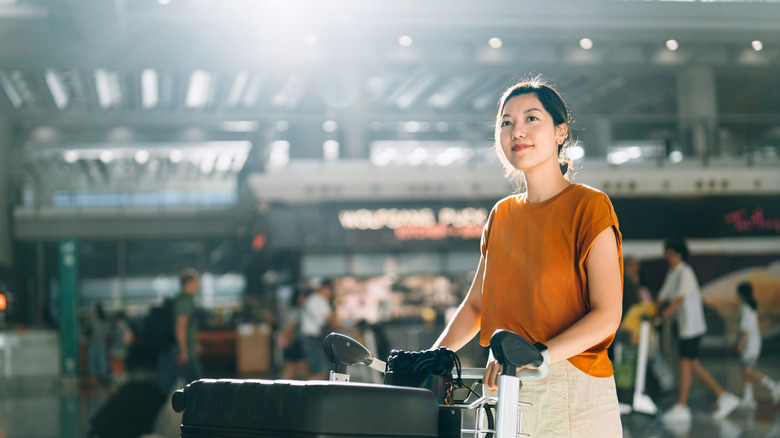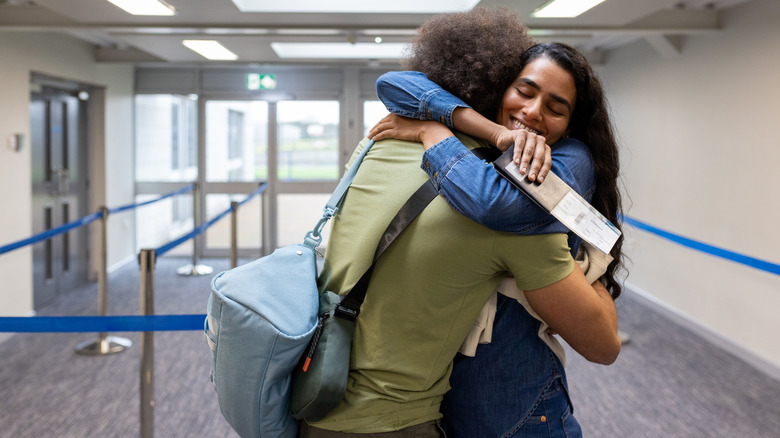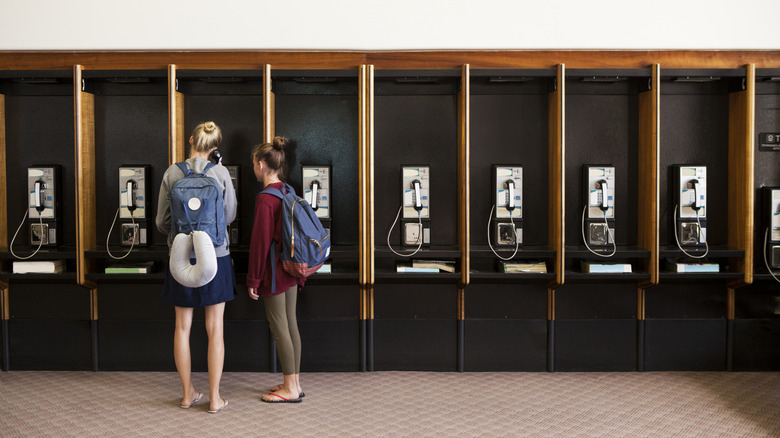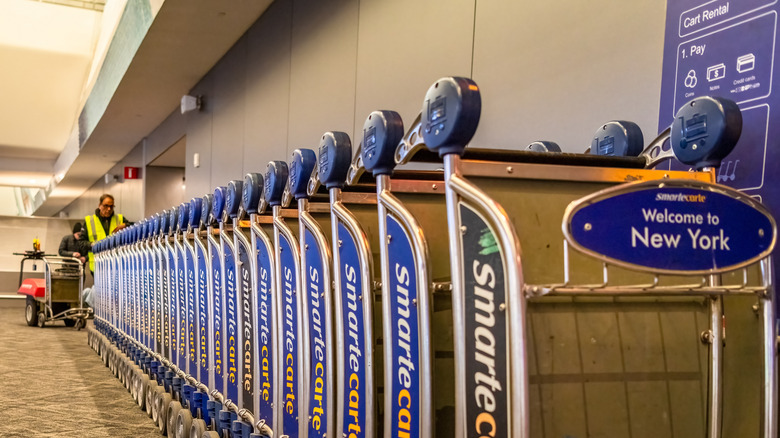The Most Nostalgic Features You Won't Find In An Airport Anywhere Nowadays
Walk into pretty much any major airport today and you'll likely find yourself surrounded by fancy self check-in kiosks, biometric scanners, and mobile boarding passes that seamlessly and efficiently handle the millions of passengers passing through. Unlike back in the day — when face-to-face check-ins and paper tickets were a pretty common sight — modern day travel is all about prioritizing efficiency and technology at every turn. Ultimately, this hunger for convenience has transformed travel hubs around the country (and the world, really) into sleek, digital environments that barely resemble their less-automated predecessors from just a few decades ago.
Because, let's be honest: If you traveled by air in the 1980s or 1990s, you probably remember a completely different airport experience. An experience where you were allowed to walk your loved ones right up to their departure gate, where free luggage carts were available and plenty, and where the unmistakable smell of smoking lounges wafting in the distance gave a distinct aroma to the entire terminal.
Nowadays, however, these once-common airport features have largely disappeared — replaced by security measures and digital alternatives that streamline the travel process. The smokers' lounges have been eliminated, observation decks have become rare attractions, and those free luggage carts? They now typically come with a pretty hefty rental fee. These clear changes show just how drastically the entire air travel experience has evolved, and the below items now exist solely in our collective travel memories.
Non-passengers at the gate
For decades, airports allowed anyone with a valid ID to simply walk through security and accompany travelers all the way to their departure gates. This meant that families could sit together until boarding time, couples could share one last coffee before a tearful goodbye, and friends could greet arrivals with welcome signs and hugs the minute they stepped out of the plane.
However, everything changed after the September 11, 2001, attacks. In the aftermath, the Transportation Security Administration (TSA) quickly implemented strict security measures that limited airport access beyond security checkpoints to ticketed passengers only. This immediate policy shift ended the long-standing tradition of gate farewells and welcomes — and created a clear separation between travelers and their loved ones way back at the security checkpoint.
That said, there are still some airports in the U.S. that have attempted to recreate this experience through visitor pass programs. In 2017, Pittsburgh International Airport launched its "myPITpass" program, essentially allowing non-travelers to bring their friends and family directly to the gate after security screening. While that program is temporarily disabled as of this writing, several other airports, including Detroit, New Orleans, and Seattle-Tacoma, followed suit, introducing similar initiatives with varying restrictions. In most cases, however, these programs require advance registration, ID verification, and security screening — which makes them a pretty limited substitute for the spontaneous gate visits of the past.
Smokers' lounges
Not all of these defunct items held positive memories for everyone. Long gone are the days of standing next to a suit-clad businessman, briefcase in hand, as he slowly takes a drag of his cigarette while waiting to board. Life isn't an episode of "Mad Men," after all, and you're probably not stepping into a time capsule that's taken you all the way back to the 1970s, either.
Smoking on planes was restricted gradually starting in the early 1970s, until President Clinton signed legislation in 2000 that prohibited smoking on all flights to, from, or within the United States. This ban eventually extended beyond aircraft and into the terminals themselves. In fact, according to the American Nonsmokers' Rights Foundation, 32 of the top 35 U.S. airports are 100% smoke-free indoors, as of 2025. This includes major hubs like Chicago O'Hare, Denver, Salt Lake City, JFK, Newark, and Atlanta's Hartsfield-Jackson Airport (famously known as the busiest airport in the world).
Nowadays, most airport smokers' lounges are becoming a thing of the past themselves, too — with airports across the U.S. prioritizing smoke-free environments instead of maintaining these isolated glass boxes that once dotted international terminals. Many airports have even redesigned these former smoking areas into well-needed amenities, like additional seating, retail shops, and charging stations. Today, only a handful of U.S. airports still allow indoor smoking, with Las Vegas and Nashville among the rare exceptions.
Observation decks
Remember when you could watch planes take off and land from an open-air platform at the airport? Decades ago, observation decks were standard features at most major airports across the world. These platforms gave aviation enthusiasts, travelers, and families a chance to experience the excitement of flight up close, with unobstructed views of aircraft operations.
From at least the 1940s through the 1970s, airports like San Francisco International, Pittsburgh International, and Westchester County Airport all had observation areas. Along with that, the iconic Theme Building at LAX also featured a popular deck where visitors could watch the growing Jet Age unfold below them. Over in Europe, the Queen's Building observation deck at London's Heathrow airport gave spectators a perfect vantage point to marvel at early jetliners, while Amsterdam Schiphol's expansive "Panorama Terrace" allowed visitors to watch aircraft from multiple angles.
Today, however, most of these observation decks have unfortunately vanished from airports, due to everything from security concerns to terminal expansions and the pressure to create more revenue-generating space. And while a few U.S. airports, like Minneapolis-St. Paul, Baltimore/Washington International, and Albuquerque International Sunport, still maintain viewing areas, they're typically enclosed spaces rather than the open-air platforms of the past. Internationally, though, observation decks live on, with airports in Munich, Zurich, Tokyo, and Amsterdam carrying on the tradition.
Pay phones
Okay, sure, this isn't necessarily an airport-only thing. Pay phones have pretty much gone out of fashion, well ... everywhere. But airports especially were once home to rows and rows of these communication lifelines. For decades, pay phones were essential for travelers who needed to do everything from confirming any hotel reservations to letting their loved ones know about flight delays and arranging transportation upon their arrival.
However, as cell phones became ubiquitous in the early 2000s, pay phones began their steady decline. Chicago's O'Hare International Airport, for example, which once had 650 pay phones available for use, reduced that number to 503 by 2017. Meanwhile, Seattle-Tacoma International Airport removed its last pay phone in 2016, with its spokesperson stating the obvious to CNBC: "Folks simply don't use pay phones." Instead, most modern airports have repurposed the valuable space once taken up by phone banks for more contemporary amenities like charging stations, ensuring travelers can keep all of their electronic devices charged as needed.
As a result, today's airport communication landscape looks drastically different. The sight of passengers hunched over their cell phones has replaced the image of travelers standing in phone booths, carefully thumbing the clunky buttons to call home. And the hunt for spare quarters? That's been replaced by passengers on the lookout for free Wi-Fi access points — completely relegating pay phones to a thing of the past.
Free luggage carts
An incredible convenience available at most airports worldwide, free luggage carts were once standard at American airports too. Designed to eliminate the need to haul heavy bags through sprawling terminals, airport luggage carts essentially make travel more accessible for families, elderly passengers, disabled travelers, and pretty much anyone jetting off with multiple suitcases in tow. Today, however, that convenience comes at a price.
This all began in 1970, when Smarte Carte introduced the first self-service luggage cart rental system. Available to travelers for a small price, the new service meant that passengers could avoid hiring porters while still getting help with their bags. That said, what initially started as a modest fee of around $1 back in 1985 has dramatically ballooned. Now, Smarte Carte charges as much as $7 per cart at certain major airports like Phoenix Sky Harbor International, while hubs like Miami International charge a whopping $9 per cart.
Today, only a handful of U.S. airports offer free luggage carts — and even then, the benefit is typically reserved for international arrivals only. This is the case in airports like San Francisco's, where the airport provides complimentary carts to international travelers, but still requires that domestic passengers pay a premium ($9 to be exact). Luckily, though, there's a clever trick that can help you secure a luggage cart for free. Simply walk outside to the arrivals area, find the taxi stand, and pick up one of the abandoned carts that previous passengers have left behind.





